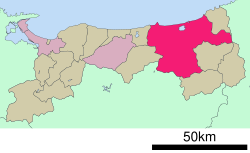Tottori, Tottori
|
Tottori 鳥取市 |
||
|---|---|---|
| Special city | ||

From top left:Tottori Castle, Shikano(old castle town), Tottori Sand Dunes, Jinpūkaku, View of Tottori from Tottori Castle
|
||
|
||
 Location of Tottori in Tottori Prefecture |
||
| Location in Japan | ||
| Coordinates: 35°30′N 134°14′E / 35.500°N 134.233°ECoordinates: 35°30′N 134°14′E / 35.500°N 134.233°E | ||
| Country | Japan | |
| Region | Chūgoku (Sanin) | |
| Prefecture | Tottori Prefecture | |
| Government | ||
| • Mayor | Yoshihiko Fukazawa | |
| Area | ||
| • Total | 765.31 km2 (295.49 sq mi) | |
| Population (June 1, 2016) | ||
| • Total | 192,912 | |
| • Density | 250/km2 (650/sq mi) | |
| Symbols | ||
| • Tree | Camellia sasanqua | |
| • Flower | Allium chinense | |
| • Bird | Blue-and-white flycatcher | |
| Time zone | Japan Standard Time (UTC+9) | |
| City hall address | 116 Shutoku-cho, Tottori-shi, Tottori-ken 680-8571 |
|
| Website | city |
|
Tottori (鳥取市 Tottori-shi?) is the capital city of Tottori Prefecture in the Chūgoku region of Japan.
As of February 28, 2015, the city has an estimated population of 192,800, with 78,431 households and a population density of 251.92 persons per km2. The total area is 765.31 km2.
Within Japan the city is best known for its sand dunes which are a popular tourist attraction, drawing visitors from outside of the prefecture. The sand dunes are also important as a centre for research into arid agriculture, hosting Tottori University's Arid Land Research Center. Most of Tottori is located in the western part of the San'in Kaigan Geopark.
The city's main street (Wakasa, or "young cherry blossom" street) runs north from the station and terminates at the foot of the Kyushouzan ("eternal pine") mountain. Around this mountain lies the oldest part of the city. Its centre is the now ruined Tottori Castle, once the property of the Ikeda clan daimyō who ruled the Tottori Domain during the Edo period. It is open to the public, and is the site of the Castle Festival in autumn each year. In the vicinity are temples, museums, and public parks. The city also hosts the prefecturally famous Shan-shan festival in the summer, which features teams of people dressing up and dancing with large umbrellas; the name 'Shan-shan' is said to come from the sound made by the small bells and pieces of metal attached to the umbrellas, which are very large. An exceptionally big example of a Shan-shan umbrella graces the main foyer of Tottori Station.
...
Wikipedia


